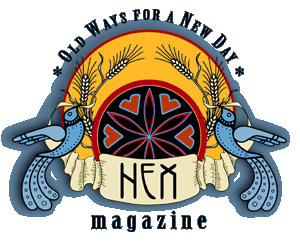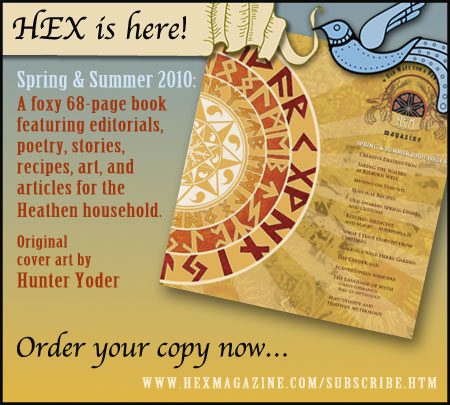21 Mar 2010 Not long ago I was directed to a story in Gylfaginning where Thor, while staying at a farmer’s house, kills his goats to make a meal of them for himself, his companions, and the family who dwell there. In the morning he waves his hammer over the goats’ skin and bones to bring them back to life. What a strange vision! I ask him to try this on me sometimes when I am feeling out of alignment. His hammer, like a giant magnet, seems to pull me into balance again. I can literally feel my muscles relaxing, my vertebrae shifting, life-force freely coursing from sacrum to skull. …
[read the full article]
21 Mar 2010 The figure of Volund has held fascination for me since I myself nearly lost the use of my legs at a young age. The accident itself was a powerful transformational experience, and as a result I have been given an artistic vision best conceived as a lifelong endeavor. To say nothing of myopic and impatient instructors in art school, following this vision has put me at odds with the very structure of modern society, as any contemporary self-employed artisan can understand. Yet this struggle is one of the central endeavors that I perceive for Heathenry if it is to have any meaningful impact on putting Midgard to rights – what we do to survive daily must be both meaningful and honorable if we are to escape the banality of the dominant consumerist culture. For me this has meant exploring and truly living as a metalsmith. …
[read the full article]
21 Mar 2010 After only four days in Iceland, four days out of the five weeks that I will spend in Scandinavia, I can already tell you that I have seen too much. Rob, my traveling mate, and I have just returned from a three day road trip around Iceland’s Highway 1, affectionately nicknamed the “ring road” by locals and tourists alike, which lines the circumference of the country. In these three days I have seen things most will only read of. I have walked the grounds of Reykholt and dipped my hand into the pool used by Snorri Sturluson; I have stood at the edge of Goðafoss and peered into the waterfall of the gods; I have wandered the paths of Dimmuborgir and stood inside the church of stone, or perhaps even looked into the entrance to Hel; I have seen Bergþórshvoll, the site of Njal’s burning; and I have climbed upon the law rock at Þingvellir and looked over its fields. …
[read the full article]
21 Mar 2010  ~ THE TURNING OF THE WHEEL ~ Ostara 2010 ~ THE TURNING OF THE WHEEL ~ Ostara 2010
Issue #6 is Here!

Support Hex! This is a community-supported not-for-profit publication. You can support us by clicking the image …
[read the full article]
21 Mar 2010 I would like to share some traditional Swabian recipes associated with the seasonal period from Landsegen (“Land-Blessing” or “Charming of the Plow”) to Ostara, together with some of their associated customs. Seasonally, the time between these two tides is marked at the beginning by the soil being ready for sowing and at the end by the start of crop growth. After Ostara, Walpurgis marks the point when grain begins to sprout from the new crops, and summer is the time of grain growth and maturation. While the outward festivities of Fasching, i.e. the revelries more commonly known as Shrovetide or Carneval, are the better-known public face of the season leading up to Ostara, it is also privately and inwardly a time of meditative self-examination, moderation, and purification. Some mistakenly believe that this is a Christian custom associated with Lent. It is not, for it was part of the agricultural rhythm of life in Swabia long before there were Christians. Why is this the case? …
[read the full article]
13 Mar 2010 I have enjoyed what I have read of Galina Krasskova’s writings, so I was quite excited to review this book. Having devoured it, I have come to the conclusion that, although there are some discordant notes that did not sit comfortably with me, it is on the whole a valuable contribution to contemporary runic lore. …
[read the full article]
13 Mar 2010 It is no secret that the modern Heathen revival has tended to be very Aesir-centric; even the term Asatru refers specifically to Odin, Thor, and their ilk, to the exclusion of their sibling family of gods, the Vanir. …
[read the full article]
13 Mar 2010 Open The Poetic Edda at a random page – particularly Lee Hollander’s canonical and nigh-unreadable translation – and you might find Norse mythology to be altogether too bizarre and cryptic to connect with. Such a reaction would be very understandable – Icelandic poetry is insanely complex and the stories seem to have been composed for an audience that already knew the background to the situations and characters. How, then, can we moderns find our way in? How can we translate the connection in our hearts into a form that permits speech and words? …
[read the full article]
11 Mar 2010 This book is essential reading for anyone interested in runes or indeed European cultural history. Macleod and Mees decline to adopt the recent fashion in academic circles for dismissing the idea that the runes had any kind of magical significance, just as they refuse to pretend that different regions were hermetically sealed from one another. They steer a balanced path between emphasising the many mundane applications of the runes and their magical function, and indeed the book focuses on the latter, as may be inferred from the title. …
[read the full article]
|
|






